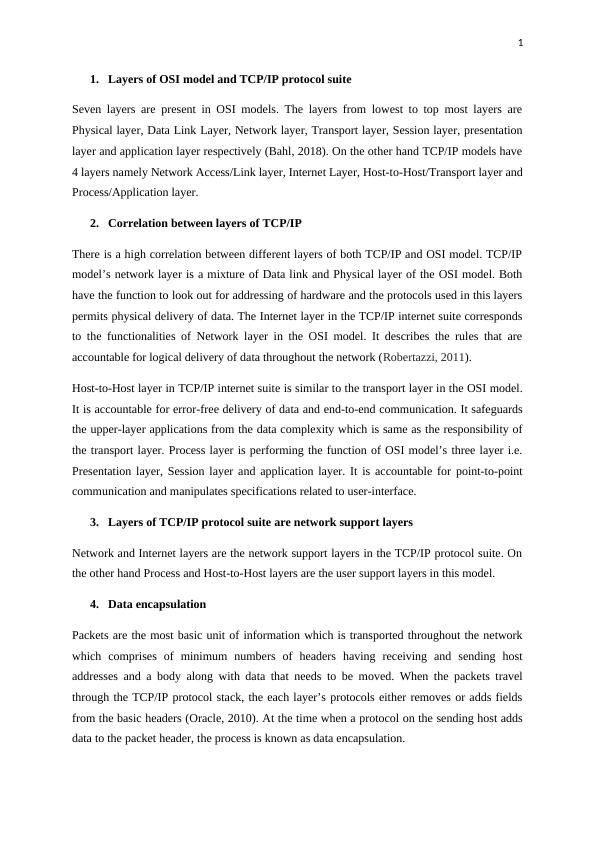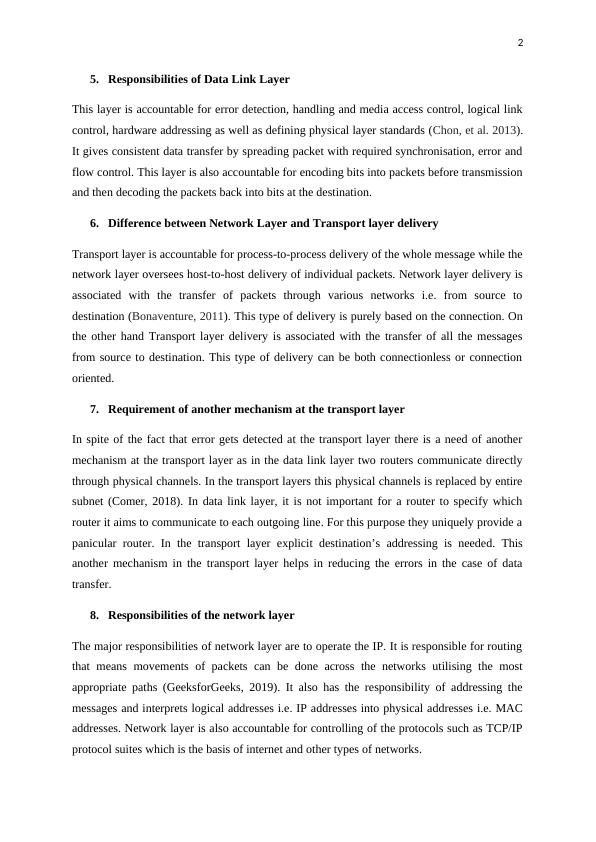Layers of OSI model and TCP/IP protocol suite
Added on 2023-04-23
7 Pages1742 Words74 Views
Assignment 1

1
1. Layers of OSI model and TCP/IP protocol suite
Seven layers are present in OSI models. The layers from lowest to top most layers are
Physical layer, Data Link Layer, Network layer, Transport layer, Session layer, presentation
layer and application layer respectively (Bahl, 2018). On the other hand TCP/IP models have
4 layers namely Network Access/Link layer, Internet Layer, Host-to-Host/Transport layer and
Process/Application layer.
2. Correlation between layers of TCP/IP
There is a high correlation between different layers of both TCP/IP and OSI model. TCP/IP
model’s network layer is a mixture of Data link and Physical layer of the OSI model. Both
have the function to look out for addressing of hardware and the protocols used in this layers
permits physical delivery of data. The Internet layer in the TCP/IP internet suite corresponds
to the functionalities of Network layer in the OSI model. It describes the rules that are
accountable for logical delivery of data throughout the network (Robertazzi, 2011).
Host-to-Host layer in TCP/IP internet suite is similar to the transport layer in the OSI model.
It is accountable for error-free delivery of data and end-to-end communication. It safeguards
the upper-layer applications from the data complexity which is same as the responsibility of
the transport layer. Process layer is performing the function of OSI model’s three layer i.e.
Presentation layer, Session layer and application layer. It is accountable for point-to-point
communication and manipulates specifications related to user-interface.
3. Layers of TCP/IP protocol suite are network support layers
Network and Internet layers are the network support layers in the TCP/IP protocol suite. On
the other hand Process and Host-to-Host layers are the user support layers in this model.
4. Data encapsulation
Packets are the most basic unit of information which is transported throughout the network
which comprises of minimum numbers of headers having receiving and sending host
addresses and a body along with data that needs to be moved. When the packets travel
through the TCP/IP protocol stack, the each layer’s protocols either removes or adds fields
from the basic headers (Oracle, 2010). At the time when a protocol on the sending host adds
data to the packet header, the process is known as data encapsulation.
1. Layers of OSI model and TCP/IP protocol suite
Seven layers are present in OSI models. The layers from lowest to top most layers are
Physical layer, Data Link Layer, Network layer, Transport layer, Session layer, presentation
layer and application layer respectively (Bahl, 2018). On the other hand TCP/IP models have
4 layers namely Network Access/Link layer, Internet Layer, Host-to-Host/Transport layer and
Process/Application layer.
2. Correlation between layers of TCP/IP
There is a high correlation between different layers of both TCP/IP and OSI model. TCP/IP
model’s network layer is a mixture of Data link and Physical layer of the OSI model. Both
have the function to look out for addressing of hardware and the protocols used in this layers
permits physical delivery of data. The Internet layer in the TCP/IP internet suite corresponds
to the functionalities of Network layer in the OSI model. It describes the rules that are
accountable for logical delivery of data throughout the network (Robertazzi, 2011).
Host-to-Host layer in TCP/IP internet suite is similar to the transport layer in the OSI model.
It is accountable for error-free delivery of data and end-to-end communication. It safeguards
the upper-layer applications from the data complexity which is same as the responsibility of
the transport layer. Process layer is performing the function of OSI model’s three layer i.e.
Presentation layer, Session layer and application layer. It is accountable for point-to-point
communication and manipulates specifications related to user-interface.
3. Layers of TCP/IP protocol suite are network support layers
Network and Internet layers are the network support layers in the TCP/IP protocol suite. On
the other hand Process and Host-to-Host layers are the user support layers in this model.
4. Data encapsulation
Packets are the most basic unit of information which is transported throughout the network
which comprises of minimum numbers of headers having receiving and sending host
addresses and a body along with data that needs to be moved. When the packets travel
through the TCP/IP protocol stack, the each layer’s protocols either removes or adds fields
from the basic headers (Oracle, 2010). At the time when a protocol on the sending host adds
data to the packet header, the process is known as data encapsulation.

2
5. Responsibilities of Data Link Layer
This layer is accountable for error detection, handling and media access control, logical link
control, hardware addressing as well as defining physical layer standards (Chon, et al. 2013).
It gives consistent data transfer by spreading packet with required synchronisation, error and
flow control. This layer is also accountable for encoding bits into packets before transmission
and then decoding the packets back into bits at the destination.
6. Difference between Network Layer and Transport layer delivery
Transport layer is accountable for process-to-process delivery of the whole message while the
network layer oversees host-to-host delivery of individual packets. Network layer delivery is
associated with the transfer of packets through various networks i.e. from source to
destination (Bonaventure, 2011). This type of delivery is purely based on the connection. On
the other hand Transport layer delivery is associated with the transfer of all the messages
from source to destination. This type of delivery can be both connectionless or connection
oriented.
7. Requirement of another mechanism at the transport layer
In spite of the fact that error gets detected at the transport layer there is a need of another
mechanism at the transport layer as in the data link layer two routers communicate directly
through physical channels. In the transport layers this physical channels is replaced by entire
subnet (Comer, 2018). In data link layer, it is not important for a router to specify which
router it aims to communicate to each outgoing line. For this purpose they uniquely provide a
panicular router. In the transport layer explicit destination’s addressing is needed. This
another mechanism in the transport layer helps in reducing the errors in the case of data
transfer.
8. Responsibilities of the network layer
The major responsibilities of network layer are to operate the IP. It is responsible for routing
that means movements of packets can be done across the networks utilising the most
appropriate paths (GeeksforGeeks, 2019). It also has the responsibility of addressing the
messages and interprets logical addresses i.e. IP addresses into physical addresses i.e. MAC
addresses. Network layer is also accountable for controlling of the protocols such as TCP/IP
protocol suites which is the basis of internet and other types of networks.
5. Responsibilities of Data Link Layer
This layer is accountable for error detection, handling and media access control, logical link
control, hardware addressing as well as defining physical layer standards (Chon, et al. 2013).
It gives consistent data transfer by spreading packet with required synchronisation, error and
flow control. This layer is also accountable for encoding bits into packets before transmission
and then decoding the packets back into bits at the destination.
6. Difference between Network Layer and Transport layer delivery
Transport layer is accountable for process-to-process delivery of the whole message while the
network layer oversees host-to-host delivery of individual packets. Network layer delivery is
associated with the transfer of packets through various networks i.e. from source to
destination (Bonaventure, 2011). This type of delivery is purely based on the connection. On
the other hand Transport layer delivery is associated with the transfer of all the messages
from source to destination. This type of delivery can be both connectionless or connection
oriented.
7. Requirement of another mechanism at the transport layer
In spite of the fact that error gets detected at the transport layer there is a need of another
mechanism at the transport layer as in the data link layer two routers communicate directly
through physical channels. In the transport layers this physical channels is replaced by entire
subnet (Comer, 2018). In data link layer, it is not important for a router to specify which
router it aims to communicate to each outgoing line. For this purpose they uniquely provide a
panicular router. In the transport layer explicit destination’s addressing is needed. This
another mechanism in the transport layer helps in reducing the errors in the case of data
transfer.
8. Responsibilities of the network layer
The major responsibilities of network layer are to operate the IP. It is responsible for routing
that means movements of packets can be done across the networks utilising the most
appropriate paths (GeeksforGeeks, 2019). It also has the responsibility of addressing the
messages and interprets logical addresses i.e. IP addresses into physical addresses i.e. MAC
addresses. Network layer is also accountable for controlling of the protocols such as TCP/IP
protocol suites which is the basis of internet and other types of networks.

End of preview
Want to access all the pages? Upload your documents or become a member.
Related Documents
TCP/IP protocol suite layer and OSI model’s layerlg...
|6
|1480
|60
Networking: Layers of OSI and TCP/IP, Data Encapsulation, SNMP Components, and Morelg...
|11
|2504
|410
IT Networking and Communication - OSI Model and TCP/IP Protocol Suitelg...
|7
|1522
|154
OSI Model and TCP/IP Model: A Comparisonlg...
|4
|787
|271
OSI Model and TCP/IP Protocol Suitelg...
|7
|1495
|490
Layers of the OSI model and TCP/IP modellg...
|5
|969
|321
